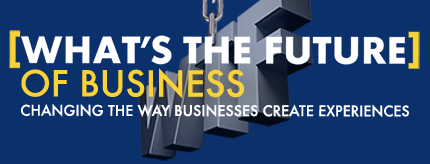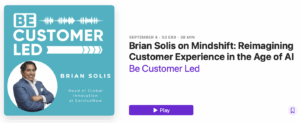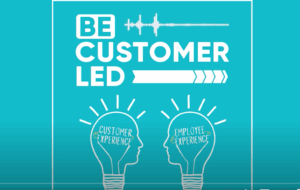Humans are emotional creatures and they want experiences that engage them as humans. They’re not eyeballs, impressions, views, likes, shares, clickthroughs, or conversions.
A few weeks ago, I visited New York on a beautiful summer day to participate in an event that I would love to repeat everywhere around the world.
Prophet, a global brand strategy firm that recently acquired Altimeter Group, hosted an intimate event to explore the new horizons of digital customer experience (DCX). I was invited to share my thoughts alongside a very enchanting and sage MaryKay Kopf, CMO at Electrolux.
While informal, it was illuminating. MaryKay shared the story of how her team helped change a company founded in 1919 to compete in a digital economy.
Attendees ranging from some of the biggest brands to the hottest startups also shared the challenges and equally solutions. I left inspired and I wanted to share with you highlights from the event so that you may feel the same.
DCX + CX = The Experience: You either add value to it or you take away from it. It’s a choice.
TL;DR: 5 Takeaways to Make Customer Experience a Competitive Advantage
1. Find your “Undercover Boss” moment
Leaders need to reconnect with what it’s like to be a customer. Empathy is key to creating rewarding customer experiences, and it has been lost in today’s corporate culture. When you are empathetic toward your customers they become more than demographics – you understand their full lives, what makes them tick, where they want to be reached and how – and therefore designing a rewarding experience for them is simple. With this level of understanding, you’ll become so in tune with your audience that you’ll be able to provide them experiences they don’t even know they want yet. A true hallmark of a relentlessly relevant brand.
2. Innovation isn’t about technology, it’s about disruption
Use the TV remote control as an example of what innovation should mean. Instead of adding new features to it or making it more powerful, try to completely re-imagine a better way to control the TV. (Hint: it’s wouldn’t be a plastic brick with 100 buttons). To create experiences that matter to your customers, first think about what the experience should be and then use technology to bring it to life.
3. The new “Kodak moment” is a cautionary tale
The rate of disruption has increased exponentially, and many Fortune 500 companies have met their demise because of it. All companies need to embrace change, both in customer behaviors and expectations and in how you think about your business. Are you an automaker or a company that provides personal transportation? If Kodak had recognized new customer behaviors and had a broader sense of their purpose as a company, they could have been the leader of the new world of photography instead of standing still – ultimately losing relevance and share.
4. Swipe right to connect with millennials
Members of this digitally native generation want to shop, work and interact with your brand the same way they date – easily and intuitively. This doesn’t mean your company (necessarily) needs to go out and build a trendy mobile app, but you do need to create an experience that is intuitive, valuable and fun for your audience. Many decision-makers in companies today are from an older generation, so it’s easy to overlook how differently millennial consumers want to interact with your brand. The good news is they aren’t shy about telling you. This generation will provide a constant stream of feedback via social media – you just have to be willing to listen.
5. Love = value creation = shareholder value
Doing the right thing by the customer might not be the most profitable decision in the short term, but it does make good business sense. If your customers love your brand, they will buy your products, recommend them to others and become a customer for life. Foster your customer’s love by delivering excellent customer experiences throughout their journey and across channels. Brand lovers are crucial to a successful company and a healthy bottom line.
(source)
Unabridged: Customer (and Employee) Experience Happens With or Without You; So, Design It
My Opening Remarks
By and large, companies want to do the right thing by their customers. The problem is they simply don’t know how. Companies are not designed around customers. Instead they have processes, budget pressures, silos and systems that reward short-term value for shareholders. When you consider this structure, it’s no wonder that customer experiences have suffered.
Remember customers are going to have an experience with your brand – good or bad – and in today’s social, digital world, they are going to share that experience. It is up to your company to ensure that experience is a good one.
More companies need to find their “Undercover Boss moment.” Leaders need to reconnect with what it’s like to be a customer. Empathy is key to creating a rewarding customer experiences. Companies have gotten good at dealing with the problem without dealing with the problem. They’ve created customer care centers, call centers, but they need to improve the actual customer experience.
Once social media empowered customers and gave weight to their voice, companies started trying to fix the experience. But they came at it the wrong way. They just wanted to shut people up, instead of trying to design/articulate a good experience that you want people to share.
Companies need to ask themselves what are the experiences people have with my brand? And what are my products? There is always a gap between the two. The question is how big is that gap and how do you fill it?
Digital customer experience is different. It can be mind-blowing for those in older generations because it’s not how we grow up. The TV remote control is a metaphor for customer experience. We don’t question it every day, but since the 50’s it’s gotten worse. It’s changed iteratively, but there has been no thought of innovation. If you were to invent the remote control today from scratch, it would look completely different.
Today’s leaders (the older generation) are making decisions by based on their experiences, but digital customers think differently. And it is almost always counter-intuitive to the older generation. Example: Millennials don’t want to buy houses. The idea of the car and car ownership will completely change in our lifetime.
This type of change is happening because companies have screwed it up. Disruption is letting customers demand a different experience.
I recently worked with Google to study micro moments – “I want to …” moments, including “I want to go to dinner, get a cab, etc.” What we found is brands are not investing in what the actual customer experience is. The customer journey is so fragmented. New, “disruptive” companies cater to customers that believe the world literally revolves around them. Think of an app – it usually brings something to you. Millennials don’t like the way most companies work. They want to work like they date – swipe right. Easy, intuitive.
How can companies create experiences that matter to their customers? Think about it should be, design it, build it and use technology to help bring it to life.
Is the rate of disruption accelerating? The book End of Business As Usual looks at how many companies that were Fortune 500, on the Nasdaq, etc. are now gone. It’s scary. The book takes a look at how many were because of bad management or digital disruption. Digital disruption companies had one thing in common. All of their boards had the opportunity to do something to stop their demise and they didn’t. Kodak had the patents for the digital camera. Now a Kodak moment means to fail to recognize a consumer change. Today companies are built around quarterly value and they make decisions based on that short-sighted view.
People at companies don’t make new/innovative decisions because of a lot of human reasons – fear, self-preservation, etc. To be innovative, people need to be safe and empowered. And most people aren’t, companies are actually very risk averse. In an effort to change this many companies are opening innovation centers to get people out of the normal work environment and to think differently.
Sephora just opened an innovation center because they discovered the way the digital generation buys make-up is totally different than their parents. At Birchbox, they try to lead the customer and design experiences that they don’t know they want yet.
Notes via Katie Lamkin
Connect with me… Twitter | LinkedIn | Facebook | Youtube | Instagram | Pinterest









Great insights that I completely agree with, including and especially the final example of Birchbox. I’ve always believed the customer experience challenge is to take people to a place that is better than they had imagined. (Congrats on the merger too!)
Thank you for the comment Jeff.
Last customer is the most important but …
Too many try to convince customer that their product/service is what they need, without even trying to hear or find out what is really need and interests of their customers.
With this way of working companies can loos loyalty of customers which is most important in work- trust and loyalty means also quality.
Btw not just large but also small companies “knows” better what customer needs then they themselves
We can have great product/great service, but if we have no people who can buy it or use it , we still have nothing, isn’t?
Great points. I think the main point is to simply change perspective. Even though we say we’re customer centric, we’re not 🙂
Hey Brian
Excellent post! Customers expect brands to create products they want and not what the former think customers need and should have. Not just market research but individualized opinion matters greatly. Brands today need to have conversations with existing and potential customers in a bid to understand them and what they need.
Kathy Spencer